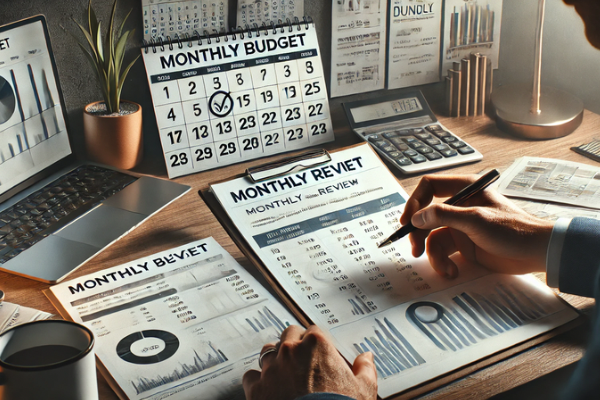Creating a budget is a great first step toward managing your finances, but the real power comes from reviewing it regularly. A budget isn’t a “set it and forget it” document — it’s a dynamic tool that should grow and change with your life. That’s why taking time to review your budget every month is essential to staying on track, adjusting to changes, and achieving your financial goals.
In this article, we’ll explore why monthly budget reviews are so important, what you should be looking at during these reviews, and how to build a simple monthly budgeting routine that keeps your finances organized and purposeful.
Why Monthly Budget Reviews Matter
Many people build a budget with good intentions, but then ignore it as the month progresses. Without regular check-ins, it’s easy to overspend, miss savings opportunities, or fall behind on goals. Reviewing your budget every month helps you stay accountable and ensures that your spending aligns with your values and priorities.
Here are some of the key reasons to review your budget monthly:
- Track progress: See how well you followed your plan and whether you met your savings or spending goals.
- Catch mistakes early: Identify any unexpected expenses, incorrect charges, or forgotten payments.
- Adjust for life changes: If your income, bills, or goals shift, your budget needs to reflect that.
- Stay motivated: Seeing your progress — even small wins — keeps you inspired to continue managing your money intentionally.
Step 1: Review Your Income
Start your monthly review by looking at your income. Did you earn what you expected? This includes your main job, side hustle income, freelance gigs, or any other sources of cash flow.
If you brought in more than expected, you can decide how to allocate the surplus — perhaps toward extra savings or debt repayment. If you earned less than planned, it may be time to adjust your spending categories or explore ways to increase your income.
Step 2: Compare Budgeted vs. Actual Spending
This is the heart of your monthly budget review. Take your original budget and compare it to what you actually spent in each category. Break it down into key spending areas, such as:
- Housing
- Utilities
- Groceries
- Transportation
- Dining out
- Personal care
- Entertainment
- Debt payments
- Savings
Ask yourself:
- Where did I stay on track?
- Where did I overspend — and why?
- Are there any habits or patterns I need to address?
This analysis gives you valuable insight into your behavior and helps you make informed decisions for the next month.
Step 3: Track Your Progress on Financial Goals
If your budget includes savings goals, debt payoff targets, or investments, check in on your progress. Did you contribute what you planned? Are you on schedule to hit your targets?
Even small steps forward should be celebrated. Progress fuels motivation and reminds you that every choice you make matters.
If you didn’t meet your goals, don’t beat yourself up — use it as an opportunity to adjust. You might need to lower your target temporarily or find new ways to cut back in other areas.
Step 4: Account for Irregular or Unexpected Expenses
Life is full of surprises. From car repairs to medical bills, unexpected expenses can throw your budget off course. During your monthly review, list any irregular expenses and consider how they impacted your plan.
If these kinds of costs keep popping up, it may be time to add new budget categories or build a more robust emergency fund. Planning ahead for these events makes them less stressful when they happen.
Step 5: Evaluate Your Spending Habits
Budget reviews aren’t just about numbers — they’re about behavior. Ask yourself how you felt about your spending during the month. Did you feel in control? Did you make any purchases you regret? Were there times you spent out of boredom or stress?
Reflecting on the “why” behind your spending can help you make better decisions moving forward. Awareness is the first step to change.
Step 6: Update and Prepare for the Next Month
After analyzing your results, use what you’ve learned to update next month’s budget. Make realistic adjustments based on the data you collected. For example:
- If you consistently overspend on groceries, increase the budget slightly and look for savings elsewhere.
- If you spent less on transportation due to remote work, redirect those funds toward savings.
- If your income changed, adjust all percentages to maintain balance.
Setting up your next month’s budget right after the review keeps everything fresh and allows you to start with clarity and intention.
Tips for Making Monthly Reviews a Habit
- Pick a consistent review date: Set a recurring reminder at the end of each month to do your review — for example, on the last Sunday of the month.
- Use a simple format: A spreadsheet, budgeting app, or paper journal — use what works best for you, but keep it simple to encourage consistency.
- Involve your partner: If you share finances, make it a team activity. Reviewing your budget together strengthens communication and shared goals.
- Celebrate wins: Every month you stay on track is a win. Reward yourself with something free or inexpensive to stay motivated.
Final Thoughts: Consistency Over Perfection
You don’t need to follow your budget perfectly every month — you just need to keep showing up. Monthly budget reviews create a rhythm of reflection and growth. They help you identify what’s working, what needs adjustment, and how to make progress without feeling overwhelmed.
Over time, this consistent review process leads to smarter decisions, fewer financial surprises, and greater peace of mind. If you want long-term financial success, reviewing your budget every month is one of the most valuable habits you can build.
